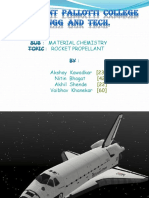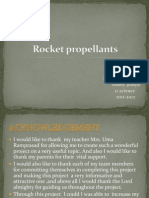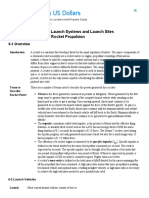Rocket Engine Uses Stored: Types
Rocket Engine Uses Stored: Types
Uploaded by
LeoCopyright:
Available Formats
Rocket Engine Uses Stored: Types
Rocket Engine Uses Stored: Types
Uploaded by
LeoOriginal Description:
Original Title
Copyright
Available Formats
Share this document
Did you find this document useful?
Is this content inappropriate?
Copyright:
Available Formats
Rocket Engine Uses Stored: Types
Rocket Engine Uses Stored: Types
Uploaded by
LeoCopyright:
Available Formats
rocket engine uses stored rocket propellants as reaction mass for forming a high-speed
propulsive jet of fluid, usually high-temperature gas. Rocket engines are reaction engines,
producing thrust in accordance with Newton's third law. Most rocket engines use
the combustion of reactive chemicals to supply the necessary energy, but non-combusting
forms such as cold gas thrusters and nuclear thermal rockets also exist. Vehicles propelled
by rocket engines are commonly called rockets. Rocket vehicles carry their own oxidizer,
unlike most combustion engines, so rocket engines can be used in a vacuum to
propel spacecraft and ballistic missiles.[citation needed]
Compared to other types of jet engines, rocket engines are the lightest and have the highest
thrust, but are the least propellant-efficient (they have the lowest specific impulse). The
ideal exhaust is hydrogen, the lightest of all elements, but chemical rockets produce a mix
of heavier species, reducing the exhaust velocity.[citation needed]
Rocket engines become more efficient at high speeds, due to the Oberth effect.[1]
Contents
TypesEdit
Here, "rocket" is used as an abbreviation for "rocket engine".
Thermal rockets use an inert propellant, heated by electricity (electrothermal propulsion)
or a nuclear reactor (nuclear thermal rocket).
Chemical rockets are powered by exothermic reduction-oxidation chemical reactions of
the propellant:
Solid-fuel rockets (or solid-propellant rockets or motors) are chemical rockets which use
propellant in a solid phase.
Liquid-propellant rockets use one or more propellants in a liquid state fed from tanks.
Hybrid rockets use a solid propellant in the combustion chamber, to which a second liquid or
gas oxidizer or propellant is added to permit combustion.
Monopropellant rockets use a single propellant decomposed by a catalyst. The most common
monopropellants are hydrazine and hydrogen peroxide.
You might also like
- Rockets and Missiles Notes PDFDocument146 pagesRockets and Missiles Notes PDFTAMILSELVAM NALLUSAMY97% (38)
- Sunder Deep Engineering College: Seminar PresentationDocument19 pagesSunder Deep Engineering College: Seminar PresentationKrishna KumarNo ratings yet
- Rocket Propellants and Their CharacteristicsDocument7 pagesRocket Propellants and Their CharacteristicsArko Dey82% (11)
- Rocket PropellantDocument28 pagesRocket Propellantgautham kumarNo ratings yet
- AMT 324 Introduction To Rocket Propulsion: V LN (M / M)Document10 pagesAMT 324 Introduction To Rocket Propulsion: V LN (M / M)Jx BunoanNo ratings yet
- Rocket Prelim and MidtermDocument14 pagesRocket Prelim and Midtermira castroNo ratings yet
- 05 Rocket Propulsion BasicsDocument5 pages05 Rocket Propulsion BasicsprasannabalajiNo ratings yet
- RocketsDocument25 pagesRocketslivillyleNo ratings yet
- Rocket Engine: Jump To Navigationjump To SearchDocument34 pagesRocket Engine: Jump To Navigationjump To SearchashokkumarNo ratings yet
- Presentation 121Document11 pagesPresentation 121Musa NabeelNo ratings yet
- Rocket PropulsionDocument61 pagesRocket PropulsionAcsah Beth AbjNo ratings yet
- Principles of Rocket PropulsionDocument21 pagesPrinciples of Rocket PropulsionShailaja UdtewarNo ratings yet
- Physics Presentation 2022Document8 pagesPhysics Presentation 2022Technical NihalNo ratings yet
- Liquid FuelDocument7 pagesLiquid FuelInfantNo ratings yet
- Rocket Engines - Origin, Developments and FutureDocument13 pagesRocket Engines - Origin, Developments and FutureDeepak Rawat100% (1)
- Rocket Fuel: Propellant Used in RocketDocument4 pagesRocket Fuel: Propellant Used in RocketRajat PangiNo ratings yet
- Rocket Propellants OverviewDocument89 pagesRocket Propellants Overviewadgeofspace04No ratings yet
- Cryogenic Rocket Engine PropellentsDocument19 pagesCryogenic Rocket Engine PropellentsRavi KiranNo ratings yet
- Rocket EngineDocument11 pagesRocket EngineAshish RanjanNo ratings yet
- Rocket PropellantDocument16 pagesRocket PropellantSAI KIRANNo ratings yet
- Cryogenic ReportDocument18 pagesCryogenic ReportAbhijeet MishraNo ratings yet
- Rocket and Missiles Lecture NotesDocument18 pagesRocket and Missiles Lecture Notes8D Audio TuneNo ratings yet
- EngineDocument14 pagesEngineChandraranga De SilvaNo ratings yet
- Mechanics PresentationDocument27 pagesMechanics PresentationNadia YasinNo ratings yet
- Rocket Propellants and Their CharacteristicsDocument7 pagesRocket Propellants and Their CharacteristicsVignesh Mahalingam100% (1)
- Sci & Tech HandoutDocument11 pagesSci & Tech Handoutmanroopshingh9711No ratings yet
- Rocket PropellantDocument54 pagesRocket PropellantTHE CALCUTTANNo ratings yet
- (Rocket Peopellant) : Internship Report OnDocument4 pages(Rocket Peopellant) : Internship Report OnKrishna RathodNo ratings yet
- Chemistry Class 11 ProjectDocument30 pagesChemistry Class 11 Projectmanisha.barbie2004No ratings yet
- Rocketpropulsionreport2 150523081225 Lva1 App6892Document20 pagesRocketpropulsionreport2 150523081225 Lva1 App6892AdityaBhagiNo ratings yet
- Unit 4Document12 pagesUnit 4raj6062No ratings yet
- Nuclear FuelsDocument8 pagesNuclear Fuelsapi-285180679No ratings yet
- Rocket EngineDocument22 pagesRocket Enginedevhx100% (1)
- All Cont. TruptiDocument14 pagesAll Cont. TruptiTruptimayee MishraNo ratings yet
- Solid RocketDocument18 pagesSolid RocketVincent S Ryan100% (8)
- Exploring Space Chapter 11 Lesson 1Document16 pagesExploring Space Chapter 11 Lesson 1Nishant MalhotraNo ratings yet
- 1101201315rocket ProppellantDocument47 pages1101201315rocket ProppellantKrishna MyakalaNo ratings yet
- Assignment No. 1 PDFDocument2 pagesAssignment No. 1 PDFJohn Ericsson RobariosNo ratings yet
- Propulsion SystemDocument17 pagesPropulsion SystemaquilesanchezNo ratings yet
- Rocket PropulsionDocument7 pagesRocket PropulsionAmrutNo ratings yet
- Cryogenic Rocket Engines ReportDocument27 pagesCryogenic Rocket Engines Reportmd junuNo ratings yet
- Cryogeni EngineDocument7 pagesCryogeni EnginechinnashivaNo ratings yet
- Ae6450 f04 Lecture1Document18 pagesAe6450 f04 Lecture1раджеш мунешварNo ratings yet
- Cryogenic Rocket Engine SeminarDocument31 pagesCryogenic Rocket Engine SeminarMahaManthra100% (1)
- Engine - WikipediaDocument73 pagesEngine - WikipediaVASEEM M S R9171No ratings yet
- A Seminar On - DocxbalwantDocument18 pagesA Seminar On - DocxbalwantAlankrit ShuklaNo ratings yet
- Rocketpropulsionreport2 150523081225 Lva1 App6892 3Document77 pagesRocketpropulsionreport2 150523081225 Lva1 App6892 3Nikkita MallickNo ratings yet
- Liqid Fuel Rocket EngineDocument10 pagesLiqid Fuel Rocket EngineBrandon Red Baron100% (1)
- Fuel CellDocument21 pagesFuel CellAnonymous 0yC5Hdg100% (1)
- Rocket Propulsion SystemDocument3 pagesRocket Propulsion SystemJal ThakkarNo ratings yet
- Design and Modal Analysis of Cryogenic Rocket Propellant TankDocument7 pagesDesign and Modal Analysis of Cryogenic Rocket Propellant TankWe learnNo ratings yet
- Cryogenic Rocket EngineDocument20 pagesCryogenic Rocket EngineBill M. SpragueNo ratings yet
- Reusable Rocket DesignsDocument9 pagesReusable Rocket Designsruhamahchandekar25No ratings yet
- 99 102, Tesma312, IJEASTDocument4 pages99 102, Tesma312, IJEASTfahad chishtiNo ratings yet
- Cryogenics and Its ImportanceDocument2 pagesCryogenics and Its ImportancesadiksnmNo ratings yet
- Cryogenic Rocket EngineDocument3 pagesCryogenic Rocket EngineAyan Kumar MajiNo ratings yet
- Chemistry of Rocket PropellantsDocument7 pagesChemistry of Rocket PropellantsH JNo ratings yet
- The Development of U.S. Missiles During the Space Race with the U.S.S.R.From EverandThe Development of U.S. Missiles During the Space Race with the U.S.S.R.Rating: 1 out of 5 stars1/5 (1)
- Neo-Assyrian Empire: Iron Age Mesopotamian Largest Empire Assyrians IronDocument7 pagesNeo-Assyrian Empire: Iron Age Mesopotamian Largest Empire Assyrians IronLeoNo ratings yet
- Components: Forests) Are More Species-Rich Than Those DominatedDocument6 pagesComponents: Forests) Are More Species-Rich Than Those DominatedLeoNo ratings yet
- Ecosystem Is A: HistoryDocument5 pagesEcosystem Is A: HistoryLeoNo ratings yet
- Nationals Park Is ADocument12 pagesNationals Park Is ALeoNo ratings yet
- Wagen Group B Platform Is A: EngineDocument3 pagesWagen Group B Platform Is A: EngineLeoNo ratings yet
- Habitat Destruction Is The Process by Which A Natural: Impacts On OrganismsDocument9 pagesHabitat Destruction Is The Process by Which A Natural: Impacts On OrganismsLeoNo ratings yet
- Biodiversity Is The Variety andDocument5 pagesBiodiversity Is The Variety andLeoNo ratings yet
- Brazil (Republic of Brazil (Portuguese: Rep: Ública Federativa Do BrasilDocument4 pagesBrazil (Republic of Brazil (Portuguese: Rep: Ública Federativa Do BrasilLeoNo ratings yet
- Audi A4: Compact Executive Cars Audi Volkswagen GroupDocument9 pagesAudi A4: Compact Executive Cars Audi Volkswagen GroupLeoNo ratings yet
- Luxury Vehicle Toyota Brand Brands Nagoya Brussels Plano, TexasDocument5 pagesLuxury Vehicle Toyota Brand Brands Nagoya Brussels Plano, TexasLeoNo ratings yet
- Kata 2Document3 pagesKata 2LeoNo ratings yet
- Chemistry Is The: EtymologyDocument3 pagesChemistry Is The: EtymologyLeoNo ratings yet
- Sports Utility Vehicle Unibody: Kata Kata Kuta Kutambu HumnDocument3 pagesSports Utility Vehicle Unibody: Kata Kata Kuta Kutambu HumnLeoNo ratings yet
- Forest Is A Large Area Dominated byDocument3 pagesForest Is A Large Area Dominated byLeoNo ratings yet
- Golf Penalties The Royal and Ancient Golf Club of ST Andrews United States Golf Association AmateurDocument2 pagesGolf Penalties The Royal and Ancient Golf Club of ST Andrews United States Golf Association AmateurLeoNo ratings yet
- Wood Is A Type Of: Club Golf Ball Hardwood Persimmon Titanium Carbon FiberDocument1 pageWood Is A Type Of: Club Golf Ball Hardwood Persimmon Titanium Carbon FiberLeoNo ratings yet
- Washington Nationals Are An American ProfessionalDocument6 pagesWashington Nationals Are An American ProfessionalLeoNo ratings yet
- History: Golf Ball Is A SpecialDocument3 pagesHistory: Golf Ball Is A SpecialLeoNo ratings yet
- Ted Irving: Geologist Geological Survey of Canada Paleomagnetism Continental DriftDocument3 pagesTed Irving: Geologist Geological Survey of Canada Paleomagnetism Continental DriftLeoNo ratings yet
- Clan Rattray Blairgowrie and Rattray Thomas Rattray: Sporting ActivitiesDocument1 pageClan Rattray Blairgowrie and Rattray Thomas Rattray: Sporting ActivitiesLeoNo ratings yet
- Golf Ball Golf Woods Irons Hybrids Putters: MaterialsDocument3 pagesGolf Ball Golf Woods Irons Hybrids Putters: MaterialsLeoNo ratings yet
- Paleomagnetism (Or Palaeomagnetism in The United Kingdom) Is The Study of The RecordDocument2 pagesPaleomagnetism (Or Palaeomagnetism in The United Kingdom) Is The Study of The RecordLeoNo ratings yet
- Mongol Empire Eurasia Mongol Devastation Deadliest Bubonic Plague Black DeathDocument2 pagesMongol Empire Eurasia Mongol Devastation Deadliest Bubonic Plague Black DeathLeoNo ratings yet
- Kata 1 ROKETDocument3 pagesKata 1 ROKETLeoNo ratings yet
- Alfred Lothar Wegener (Document4 pagesAlfred Lothar Wegener (LeoNo ratings yet
- Electron Acceptors: TetracyanoquinodimethaneDocument2 pagesElectron Acceptors: TetracyanoquinodimethaneLeoNo ratings yet
- With The - It Is An of K and NO, and Is Therefore An .: Potassium Nitrate Is ADocument6 pagesWith The - It Is An of K and NO, and Is Therefore An .: Potassium Nitrate Is ALeoNo ratings yet
- Calcite: and The Most Stable of (Caco) - The, Based On, Defines Value 3 As "Calcite"Document4 pagesCalcite: and The Most Stable of (Caco) - The, Based On, Defines Value 3 As "Calcite"LeoNo ratings yet
- Kata Kata Kuta Kutambu Humn HJMGJ Jantang: Airplane or Aeroplane (Informally Plane) IsDocument5 pagesKata Kata Kuta Kutambu Humn HJMGJ Jantang: Airplane or Aeroplane (Informally Plane) IsLeoNo ratings yet
























































































